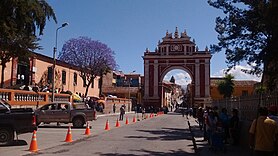You can help expand this article with text translated from the corresponding article in Spanish. Click [show] for important translation instructions.
|
Ayacucho
Huamanga San Juan de la Frontera de Huamanga | |
|---|---|
Plaza de Armas de Ayacucho Mirador Acuchinay Observatory Templo de Santo Domingo de Guzmán Mariscal Sucre Monument | |
| Nickname: The City of Churches | |
| Coordinates: 13°09′47″S 74°13′28″W / 13.16306°S 74.22444°W | |
| Country | Peru |
| Region | Ayacucho |
| Province | Huamanga |
| District | Ayacucho |
| Settled | April 25, 1540 |
| Government | |
| • Mayor | Yuri Gutiérrez |
| Area | |
| • Total | 2,981.37 km2 (1,151.11 sq mi) |
| Elevation | 2,761 m (9,058 ft) |
| Population | |
| • Total | 180,766 |
| • Density | 61/km2 (160/sq mi) |
| Demonym(s) | Ayacuchano, -1 |
| Time zone | UTC-5 (PET) |
| • Summer (DST) | UTC-5 (PET) |
| Area code | 66 |
| Website | http://www.munihuamanga.gob.pe/ |
Ayacucho (Spanish pronunciation: [aʝaˈkutʃo] , Quechua: Ayak'uchu, derived from the words aya ("death" or "soul") and k'uchu ("corner") in honour of the battle of Ayacucho), founded in 1540 as San Juan de la Frontera de Huamanga and known simply as Huamanga[2] (Quechua: Wamanga) until 1825,[3] is the capital city of Ayacucho Region and of Huamanga Province, Ayacucho Region, Peru.
Its original name, which continues to be the alternative name of the city, dates back to the Incan and Viceregal periods of its history, until its official change by Simón Bolívar in 1825 through a decree to commemorate the battle of Ayacucho during the Peruvian War of Independence. Bolívar issued the decree on February 15, 1825,[4][5] changing the name from "Huamanga" to "Ayacucho",[5] after the battle that decisively established the total independence of the nascent Peruvian Republic.[5][6]
Ayacucho is famous for its 33 churches, which represent one for each year of Jesus' life. Ayacucho has large religious celebrations, especially during the Holy Week of Easter. These celebrations include horse races featuring Peruvian Caballos de Paso and the traditional running of the bulls, known locally as the jalatoro or pascuatoro. The jalatoro is similar to the Spanish encierro, except that the bulls are led by horses of the Morochucos.[citation needed]
- ^ Instituto Nacional de Estadística e Informática, Perfil Sociodemográfico del Perú Archived November 14, 2012, at the Wayback Machine pp. 30.
- ^ Klaiber, Jeffrey (September 1, 2009). The Church, Dictatorships, and Democracy in Latin America. Wipf and Stock Publishers. ISBN 9781606089477.
Furthermore, the citizens of Ayacucho point with pride to the thirty-three churches that go back to colonial Huamanga (Ayacucho's name then).
- ^ "Copia de Decreto que cambia nombre a Huamanga". Biblioteca Bicentenario. February 15, 1825.
- ^ Peru; S, Justino M. Tarazona (1968). Demarcación política del Perú: 1821-1967 (in Spanish). p. 644.
El Libertador Simón Bolívar expidió el decreto de 15 de febrero de 1825 por el que se cambió el nombre de "Huamanga" por el de "Ayacucho", pues la "victoria de Ayacucho ha afirmado para siempre la Independencia total de la República"
- ^ a b c statutes, Peru (1861). Coleccion de leyes, decretos y órdenes publicadas en el Perú desde el año de 1821 hasta 31 de diciembre de 1859 reimpr. por orden de materias por J. Oviedo (in Spanish).
- ^ Peru (1968). Demarcación política del Perú: recopilación de leyes y decretos, 1821-1967 (in Spanish). Ministerio de Hacienda y Comercio. Dirección Nacional de Estadística y Censos. p. 644.
2°—Que, obtenida la victoria en el Departamento de Huamanga, debe marcarse su nombre, de una manera que perennemente recuerde a aquellos habitantes el origen de su libertad









